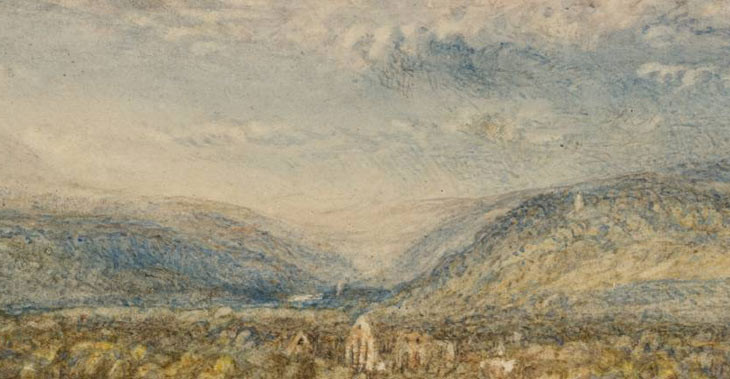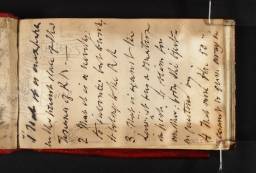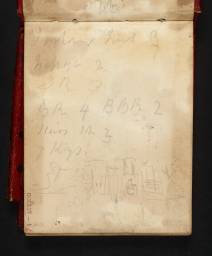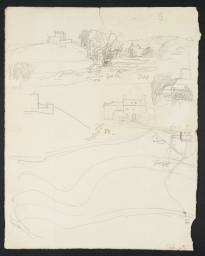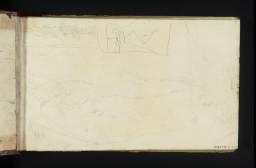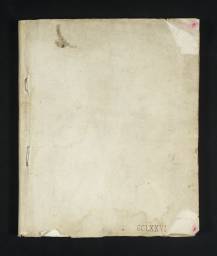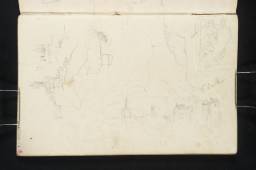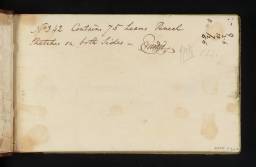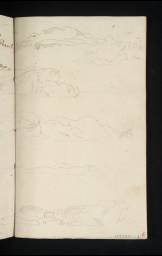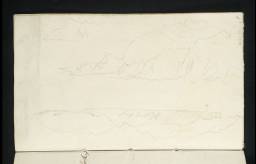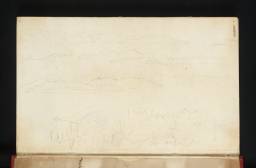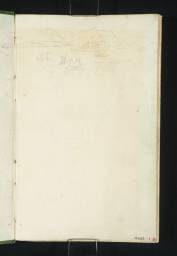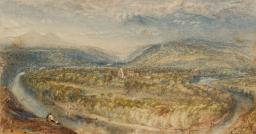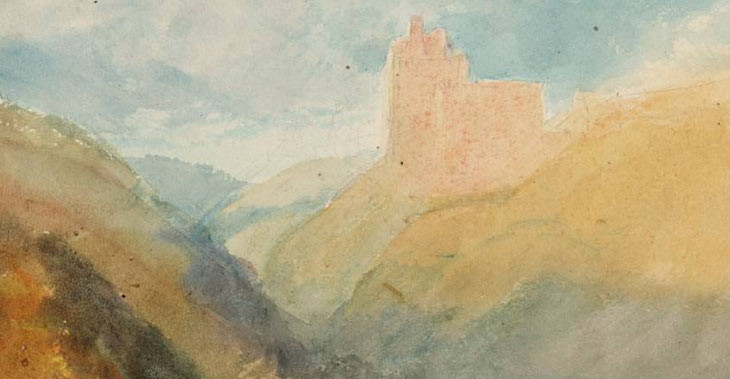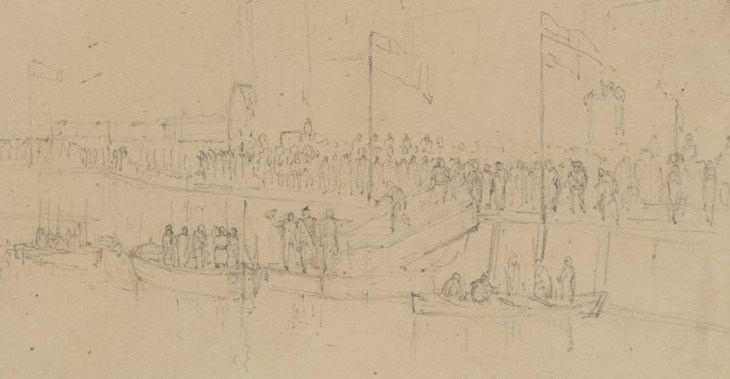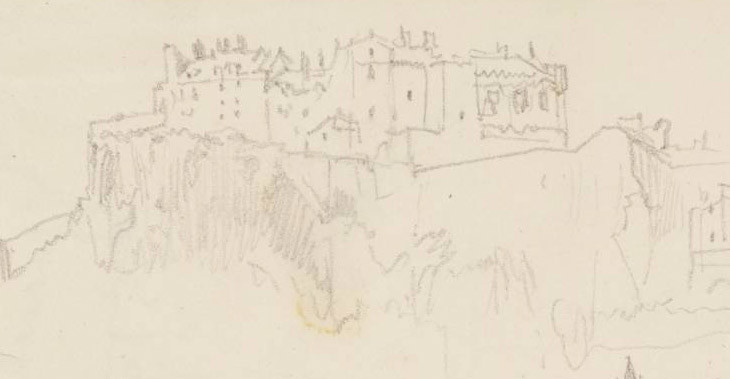From the entry
In late February 1831 Turner was approached by the Edinburgh publisher Robert Cadell with a proposition to paint twenty-four watercolours to be engraved as illustrations to a new edition of Sir Walter Scott’s collected Poetical Works. Turner’s association with the poet and publisher had begun in 1818 when he contributed illustrations to Scott’s Provincial Antiquities and Picturesque Scenery of Scotland (see 1818 Scottish Tour Introduction). His recent illustrations to Samuel Rogers’s Italy, A Poem had proved so popular that Cadell was convinced that he was the only artist for the job. Turner agreed to the commission, but was initially reluctant to return to Scotland to make any further sketches, suggesting that he already had fifteen suitable pencil studies and could base the other illustrations on sketches or prints by other artists. Scott and Cadell were concerned that without original sketches as the foundation of his paintings, Turner’s designs would ...
Sound of Mull No. 1 sketchbook 1831
D26936–D26948; D26950–D26954; D41019–D41020
Turner Bequest CCLXXIV
D26936–D26948; D26950–D26954; D41019–D41020
Turner Bequest CCLXXIV
D12109
Turner Bequest CLIV K
Turner Bequest CLIV K
D34001
Turner Bequest CCCXLI a 284
Turner Bequest CCCXLI a 284
D34002
Turner Bequest CCCXLI a 285
Turner Bequest CCCXLI a 285
D34015–D34017, D34791–D34794, D34796, D34797, D34836, D34842–D34849, D34857, D34858, D40396
Turner Bequest CCCXLI 297, 298, 298v, CCCLXIV d 324–327, 329, 330, 353, 357–361v, 369, 370, 370v
Turner Bequest CCCXLI 297, 298, 298v, CCCLXIV d 324–327, 329, 330, 353, 357–361v, 369, 370, 370v
Dryburgh Abbey circa 1832
N05241
Bequeathed by Beresford Rimington Heaton 1940
N05241
Bequeathed by Beresford Rimington Heaton 1940
D41538
Turner Bequest CCLXXIV 7
Turner Bequest CCLXXIV 7
References
In late February 1831 Turner was approached by the Edinburgh publisher Robert Cadell with a proposition to paint twenty-four watercolours to be engraved as illustrations to a new edition of Sir Walter Scott’s collected Poetical Works.1 Turner’s association with the poet and publisher had begun in 1818 when he contributed illustrations to Scott’s Provincial Antiquities and Picturesque Scenery of Scotland (see 1818 Scottish Tour Introduction). His recent illustrations to Samuel Rogers’s Italy, A Poem had proved so popular that Cadell was convinced that he was the only artist for the job.2
Turner agreed to the commission, but was initially reluctant to return to Scotland to make any further sketches, suggesting that he already had fifteen suitable pencil studies and could base the other illustrations on sketches or prints by other artists. Scott and Cadell were concerned that without original sketches as the foundation of his paintings, Turner’s designs would look hackneyed and the public would be less enthusiastic about the venture. 3 In an attempt to persuade Turner to make the journey Scott sent him a personal invitation to his home, Abbotsford. He and Cadell also pursued the possibility of hiring the Scottish artist James Skene to provide Turner with new sketches.4 In the event the letter worked, and Turner, flattered, accepted the invitation and told the poet that as he was going so far north he would take the opportunity to travel more widely and see ‘Staffa Mull and all’.5
The choice of the frontispiece and vignette to illustrate each of the twelve volumes was the subject of much debate between Scott and Cadell, and also took into consideration Turner’s advice and the suitability of his sketches.6 The illustrations were to depict landscape or architecture described or alluded to in the principal poem of each volume, or associated with Scott’s life.7 Turner did not set out to illustrate the narrative of the poems, or create an historic setting, but depicted the landscape as he saw it, though with reminders of the past in the shape of antiquities and ruins. He was particularly taken by the biographical element of the chosen subjects, and chose to depict Scott in several of the designs, and allude to him and his life in others.8
Below is a list of Turner’s watercolour designs for Sir Walter Scott’s Poetical Works, with reference to the principal sketches on which they were based. They are listed by the volume in which they appeared as engravings.
I. The Minstrelsy of the Scottish Border
II. The Minstrelsy of the Scottish Border
III. The Minstrelsy of the Scottish Border
IV. The Minstrelsy of the Scottish Border
V. Sir Tristrem
VI. The Lay of the Last Minstrel
VII. Marmion
VIII. The Lady of the Lake
IX. Rokeby
Frontispiece: Junction of the Greta and the Tees circa 1832 (whereabouts unknown);25 see Tate D25830–D25831; Turner Bequest CCLXVI 35a–36
X. The Lord of the Isles
XI. The Bridal of Triermain
XII. Dramas
Turner used twelve sketchbooks and a handful of loose sheets during his tour. At least two of the books (probably four of them) were purchased while on tour.33 These books were not singly or sequentially in a consistent manner. Instead Turner often used two books at once, or put a book away for a while before returning to it later. While there is sometimes a rough sequence of sketches that follow the page order (or the reverse page order), Turner was in the habit of turning his books around to different orientations, flipping backwards and forwards through a book as he used it, or turning to an apparently random page and thus disrupting the order. Reconstructing Turner’s tour by the order of sketches in the books is therefore troublesome. Below is a summary of the scholarship relating to the 1831 tour, followed by a proposed itinerary that attempts to demonstrate the order in which the sketchbooks were used.
The first published account of Turner’s visit to Scotland in 1831 was in John Gibson Lockhart’s Memoirs of the Life of Sir Walter Scott, Bart, 1837. A short passage described Turner’s visit to Sir Walter Scott’s home, Abbotsford, and his excursions around the area with Scott and Cadell. Lockhart wrote that he and James Skene were present on these occasions;34 however, Cadell’s diary proves that they were not, and therefore Lockhart’s account is not entirely reliable.35
Turner’s first biographer, Walter Thornbury, quoted Lockharts’ account in its entirety, but provided little additional information apart from two anecdotes from the trip. The first is that ‘but for one or two tufts of grass he must have broken his neck, having slipped when trying to attain the best position for taking the view’ of Loch Coruisk.36 The second is the report of Turner doffing his cap as he passed Norham Castle, though Thornbury confuses the date by associating the anecdote with the Provincial Antiquities tour of 1818 instead of the 1831 tour.37 Thornbury also provides evidence that the tour was over by 23 September.38
From his study of the sketchbooks, as well as the letters between Turner, Scott and Cadell, and Scott’s diary, Finberg was able to give a brief account of the contract and preparations for the tour,39 and suggest an itinerary, which is largely correct, though he made a few incorrect assumptions and conflated it with part of the 1834 tour of Scotland. Finberg’s main mistake was with the order of the sketchbooks. He placed the Rokeby and Appleby and Berwick sketchbooks before the Minstrelsy sketchbook and read the Abbotsford sketchbook back to front, which lead to the assumption that Turner went to Berwick upon Tweed and Edinburgh before Abbotsford. He was also wrong in regarding the Stirling and Edinburgh (Tate D26259–D26435; D41047–D41049; Turner Bequest CCLXIX), and the Loch Ard (D26667–D26747; Turner Bequest CCLXXII) sketchbooks as being belonging to the 1831 tour, and therefore assuming that Turner visited Lochs Ard and Venachar and the Falls of the Clyde in 1831.40
Scott, Cadell and Turner’s selection of the subjects to illustrate the Poetical Works is revealed in Adele Holcomb’s 1971 article which draws upon the correspondence between the artist, poet and publisher but is still dependent on Lockhart, Thornbury and Finberg for information about Turners’ visit to Abbotsford.41 A detailed account of the Abbotsford visit is provided by Gerald Finley who in 1972 transcribed much of Robert Cadell’s ‘Abbotsford Diary’ giving a detailed account of the time he spent with Turner at Scott’s house, the surrounding countryside and in Edinburgh.42
Finley divulged further evidence in another article,43 and expanded his study of Turner and Scott’s relationship in his book, Landscapes of Memory: Turner as Illustrator to Scott, 1980. This book is indispensable as a discussion of the Poetical Works project, but devotes little space to Turner’s movements after leaving Edinburgh. In his brief consideration of the later itinerary, Finley repeats Finberg’s mistaken inclusion of some of the 1834 sketchbooks.44 He does, however, mention for the first time that on the final leg of the tour the artist travelled to Aberdeen before returning to Edinburgh.45
The two sketches of Aberdeen were first discussed in the exhibition catalogue for Turner in Scotland, 1982, which also made various new identifications.46 Here Francina Irwin described how Turner made use of the new steamboat services that operated on the Scottish lochs, canals and off the west coast, suggesting a number of steamboat tours that he may have taken to complete his journey.
In the early 1990s Dr David Wallace-Hadrill and Janet Carolan expanded this research with a series of articles on the second half of Turner’s 1831 Scottish itinerary. Several of these were published,47 while others exist as unpublished manuscripts along with the authors’ notes, which are held as part of Tate’s catalogue files.48 Some of the unpublished material revises the published work. Wallace-Hadrill and Carolan’s identifications and conclusions have been invaluable to the present catalogue, which also makes new identifications, and draws new conclusions about the itinerary.49
Turner’s itinerary in Scotland in 1831, as deduced from the sketchbooks, the scholarly work cited above, and new research is set out below. Further information can be found in the relevant sketchbook introductions, and under the catalogue entries cited. Reference is made to Turner’s illustrations to Scott’s Poetical Works and to other watercolours and paintings that resulted from sketches made on this tour.
Having agreed to make the journey north to collect original sketches for the Poetical Works, Turner had several meetings with Robert Cadell who visited him in London in mid-June to discuss the itinerary.50 Cadell reported finding Turner ‘all ready with maps and road books’, which they went through, settling on a journey north by steamboat to Edinburgh, followed by a coach to Abbotsford, back to Edinburgh and onto the Trossachs, before heading to Glasgow and from there to the Western Isles.51 He was to leave by 20 July,52 and was presumably to cover the northern English subjects on his return journey. Turner changed his mind, however, writing to Cadell to inform him of his plan to coach to Abbotsford, covering the north England subjects on the way.53
As Finberg noted, Turner left London shortly after attending the Royal Academy’s General Assembly on 18 July. He travelled to Worcester, Bridgnorth, Shrewsbury, and Chester making sketches in the Worcester and Shrewsbury sketchbook (Tate D18591–D18592; D22151–D22322; D41053–D41055; Turner Bequest CCXXXIX complete), and continued to Liverpool (Tate D25763; Turner Bequest CCLXVI 1a) and Manchester (Tate D25702; Turner Bequest CCLXV 34), perhaps making the journey by the Liverpool-Manchester Railway.54 Cadell records in his diary that Turner reached Manchester by 22 July and Penrith by 28 July.55 Passing through Preston, he reached Kendal in the Lake District before continuing to Keswick and Derwentwater, where he sketched Skiddaw for the frontispiece to The Bridal of Triermain. Near Penrith Turner made sketches of Mayburgh Henge for the vignette to the same volume. Further sketches of these sites were made in the Rokeby and Appleby sketchbook which was used alongside the Minstrelsy sketchbook for a time.
Turner travelled east to Rokeby Park in Country Durham to make sketches for the Rokeby volume. The journey is recorded in the Rokeby and Appleby sketchbook which he used to make numerous rapid sketches during this part of the tour, alongside more finished sketches in the Minstrelsy sketchbook. A sketch of the Greta and Tees rivers, with Mortham Tower, was used as the basis for the frontispiece to Rokeby, with Bowes Castle for the vignette. Turner also took a particular interest in Barnard Castle and Egglestone Abbey.
Using the Minstrelsy sketchbook as he went, he returned to Penrith before heading north to Carlisle. This was the subject of the frontispiece to volume 1 of The Minstrelsy of the Scottish Border. He crossed the border and headed to Dumfries, which was his base for excursions to New Abbey (which was later used for a Prose Works design: New Abbey, Near Dumfries circa 1833, private collection),56 Lincluden Colligate Church and Caerlaverock Castle. The latter was used for the frontispiece to volume 4 of the Minstrelsy , and Caerlaverock also featured in a design engraved for Illustrations to the Waverly Novels (1836), a project unconnected to Robert Cadell: Col. Mannering, Hazlewood, and Smugglers circa 1835 (watercolour, private collection).57
From Dumfries Turner began a journey east towards Lochmaben Castle near Lockerbie which he sketched for the vignette to Minstrelsy volume 3; he also made another watercolour of the subject.58 From Lockerbie he went to see Johnny Armstrong’s Tower near Gilnockie in preparation for the vignette for volume 2 of the Minstrelsy. Heading north up the River Esk he reached Langholm on 2 August.59 The next day he proceeded north-east to Hawick, and on 4 August made a round trip to Hermitage Castle which he sketched for the vignette to Minstrelsy volume 4. He returned that evening to Hawick and hired a gig that night which brought him to Abbotsford at eight o’clock.60
Turner stayed at Abbotsford from 4 to 9 August, during which time he took a number of day trips to the surrounding country accompanied by Cadell and sometimes Scott, during which he made sketches in the Abbotsford book.61 The first trip on 5 August was to Scott’s former home of Ashestiel, which was to be the vignette illustration to Marmion.
On 6 August they visited Smailholm Tower, which Turner sketched for the vignette to volume 1 of the Minstrelsy. He also made two further watercolours based on the sketches, one for Lockhart’s Life of Scott – Sandy Knowe or Smailholm Tower circa 1836 (Vassar College Art Gallery, Poughkeepsie, New York),62 – and one as a gift for Scott: Smailholm Tower and Sandyknowe Farm 1832 (Courtauld Gallery, London). On the return to Abbotsford they visited Bemerside Hall, which was illustrated as the vignette to Sir Tristrem.
Turner visited Newark Castle on 7 August for the Lay of the Last Minstrel vignette. That evening he visited Chiefswood Cottage and made sketches of the Rhymers Glen, which contributed towards the design of a vignette to Scott’s Prose Works: Rhymer’s Glen, Abbotsford circa 1834 (watercolour, National Gallery of Scotland).63
On 8 August Turner sketched the ruins of Dryburgh Abbey for the frontispiece to Sir Tristram, Melrose for the frontispiece to the Lay of the Last Minstrel, and Abbotsford for the vignette to The Dramas. Sketches of Abbotsford also contributed to an illustration to Lockhart’s Life of Scott: Abbotsford from the Northern Banks of the Tweed circa 1838 (private collection).64 A view of Abbotsford painted on a metal tray, which some writers have attributed to Turner, has also been associated with Turner’s visit: Abbotsford 1834–6 (Indianapolis Museum of Art, Indiana).65
On 9 August Turner and Cadell left for Berwick upon Tweed,66 reaching Jedburgh Abbey by three o’clock which the artist sketched for the frontispiece to Minstrelsy of the Scottish Borders (volume 2). That evening they reached Kelso, which Turner sketched the next day for the frontispiece to volume 3 of the Minstrelsy. They left Kelso and coached to Berwick-upon-Tweed, passing Norham Castle on the way. Although Norham was engraved as an illustration to Scott’s Prose Works, the design was not based on sketches made at this time: Norham Castle – Moonrise circa 1833 (private collection).67 That evening and the next morning Turner sketched Berwick for his frontispiece to the Dramas. Turner made his way to Edinburgh via Dunbar and Haddington, arriving on 13 August. On 15 August he sketched Edinburgh for the frontispiece to Marmion. Both the Berwick and Edinburgh sketchbooks were used alongside Abbotsford during this period.
On 16 August Turner set off on the next stage of his tour, leaving Edinburgh by coach for South Queensferry where he caught a ferry to Stirling, visiting Dunfermline on the way where he made sketches in the Stirling and the West sketchbook .68 The journey along the Firth of Forth to Stirling was recorded in the Loch Long sketchbook. At Stirling he used the Stirling and the West sketchbook for views of the town and castle.69
Rather than going straight to the Trossachs, as Cadell had suggested, and previous scholars have assumed (see above), Turner seems to have headed south-west to Dumbarton, presumably via Glasgow, though there are no sketches of the city. He took up his pencil again at Dumbarton on the Clyde, making a sketch of Dumbarton Rock and Castle which was used as the basis for a vignette to Scott’s Prose Works: Dumbarton Castle circa 1833 (whereabouts unknown).70 Wallace-Hadrill and Carolan have suggested in an unpublished article that from here Turner embarked on three steamboat tours.71
The first tour was to Loch Lomond, Loch Arklet, Loch Katrine and Loch Achray and was made to collect sketches of Loch Katrine and Loch Achray for the frontispiece and vignette to The Lady of the Lake.
Turner combined two tours for the second trip which from the Clyde brought him half way up Loch Long, and then up Loch Goil to Lochgoilhead from where passengers were conveyed by coach to St Catherine, and by ferry across Loch Fyne to Inveraray. Turner returned by a different route through Glen Croe to the head of Loch Long and returned by water to the Clyde. He used the Loch Long sketchbook alongside the Stirling and West book during this tour (see the introductions to those books for references).
The third tour, recorded in Stirling and the West, was to Islay and took the artist to the mouth of the Clyde and through the Kyles of Bute to East Loch Tarbert, where passengers disembarked to cross the Kintyre peninsular to West Tarbert, boarding another ferry bound for Port Askaig on Islay. There were no commissioned subjects to sketch on this tour, though Turner sketched as he went, taking a particular interest in Finlaggan Castle.
The artist returned to East Loch Tarbert and from there to Inveraray, heading north by land to Loch Awe which he rounded or crossed before continuing north to the southern shore of Loch Etive. Here he took up the Staffa sketchbook and drew Dunstaffanage Castle – which was used for a Prose Works illustration: Dunstaffnage circa 1832–5 (Indianapolis Museum of Art) – and Dunollie Castle on his way to Oban.72 Oban was the base for Turner’s travels around the Western Isles. Having sketched the town and environs, and the nearby island of Kerrera with the romantic ruins of Gylen Castle, he took a boat to Skye, passing through the Sound of Mull where he had his first opportunity to sketch the ruined castles of Duart, Ardtornish and Aros in the Sound of Mull no.1 and the Sound of Mull no.2 sketchbooks.
Landing at Advarsar on the eastern shore of Skye, Turner took up the Stirling and the West sketchbook once again, making several rough sketches of Castle Camus (Knock Castle), before heading west to Dun Sgathaich Castle at Tokavaig where he crossed Loch Slapin to Straithaird and onto Elgol. From Elgol he took a boat on Loch Scavaig to reach the entrance to Loch Coruisk which he sketched from the mountain of Sgurr na Stri for the frontispiece to the Lord of the Isles volume. From Elgol Turner went north-east around the head of Loch Slapin and onto Broadford. He sketched Castle Maol at Kyleakin before boarding a boat that took him through the Kyles of Rhea on his way to Tobermory on Mull.
At Tobermory the artist returned to the Staffa sketchbook and made sketches of the village. From here he embarked on a day trip to Staffa by steamboat. Sketches of Fingal’s Cave formed the basis of his vignette illustration to The Lord of the Isles. The trip also inspired Turner’s oil painting, Staffa, Fingal’s Cave, (Yale Center for British Art, Paul Mellon Collection),73 which was exhibited the following year at the Royal Academy.
Turner returned to Tobermory, where he presumably spent the night, before returning to Oban and beginning a journey north up the Lynn of Lorn and out into Loch Linnhe, passing Castle Stalker on his way to Ballachulish. Here he broke his journey to make a round trip to Glencoe, providing useful source material for his illustration to Scott’s Prose Works: Glencoe circa 1833 (Rhode Island School of Design).74
Continuing north, Turner reached Fort William where he entered the Caledonian Canal and began sketching in the Fort Augustus sketchbook. He sketched Ben Nevis from Thomas Telford’s Neptune’s Staircase before continuing north along Loch Lochy and Loch Oich where he drew Invergarry Castle. Reaching Fort Augustus Turner made a sketch that was used as the basis for an illustration to Scott’s Prose Works: Fort Augustus, Loch Ness circa 1833 (private collection).75 He entered Loch Ness, stopping at Foyers to draw the waterfall and sketching Urquhart Castle on the opposite bank.
Reaching Inverness at the end of the Caledonian Canal Turner purchased the Inverness sketchbook. His sketches of Inverness formed the basis of a Prose Works design: Inverness, circa 1833 (Inverness Museum and Art Gallery, The Highland Council).76 From Inverness he made his way north across the Black Isle peninsular to Evanton where he visited Hugh Munro at Novar House (see Sheets Associated with the 1831 Tour of Scotland Group Introduction). He toured around the local area with Munro, making a handful of sketches on loose sheets of the Black Rock Gorge and the Cromarty Firth before crossing the Firth to the Black Isle and sketching Fort Rose and Fort George. Travelling east, Turner visited Elgin where he made sketches of the cathedral in the Inverness book before heading south-east to Aberdeen where he boarded a boat bound for Edinburgh. He met Cadell on 17 September,77 and probably left the capital by steamboat the next day,78 travelling via Newcastle where he made sketches in the Worcester and Shrewsbury sketchbook (Tate D22165; Turner Bequest CCXXXIX 9), and arriving in London by 23 September.
Turner’s extensive two-month tour of Scotland, while apparently leaving him rather exhausted,79 gave him the source material for the twenty-four designs to illustrate Scott’s Poetics Works as well as a portfolio of sketches recording many parts of Scotland from the borders to the Highlands, Western Isles and Ross-shire. Some of these was later utilised for two further projects with Robert Cadell: a new edition of the Prose Works which followed the Poetical Works and was uniform with it, and Lockhart’s Life of Scott. Several of the sketches were also used for illustrations to G.N. Wright’s Landscape – Historical Illustrations of Scotland and the Waverly Novels, though these were commissioned by another publisher, Fisher and Co. Turner made only one oil painting based on the tour, Staffa, Fingal’s Cave which he prepared for the 1832 Royal Academy summer exhibition.80
Although Scott died in 1832 and the Poetical Works did not sell as well as Cadell had hoped,81 the publisher did not give up on the project of publishing illustrated editions of the poet’s work. He approached Turner in February 1833 to illustrate an edition of the Waverly Novels and in May 1834 he met the artist to discuss Scott’s Prose Works and Lockhart’s Life of Scott.82 This led to Turner’s final tour of Scotland in 1834 and a two further sets of watercolours illustrations;83 (see Tour of Scotland for Scott’s Prose Works and the Life of Scott 1834 Tour Introduction).
Note: Additional sheets relating to Fingal’s Cave (D34015–D34017; Turner Bequest CCCXLI a 297, 298, 298v) were identified in 2016 and included in the ‘Sheets Associated with the 1831 Tour’ subsection. The present introduction is otherwise unrevised.
Cadell’s letter is untraced but has been numbered 168a by John Gage (John Gage, ‘Further Correspondence of J.M.W. Turner’, Turner Studies: His Art and Epoch 1775–1851, Summer 1986 vol.6 no.1, p.4 letter 168a). It is referred to in Robert Cadell’s diary, which is discussed in Gerald Finley, Landscapes of Memory: Turner as Illustrator to Scott, London 1980, p.74. Finley’s discussion of Cadell’s diary will be referred to frequently in this introduction.
Adele Holcomb discusses the distinction between ‘ideal’ (narrative) illustration and ‘real’ illustration (the depiction of settings) with regards to the Poetical Works in her article: Adele M. Holcomb, ‘Turner and Scott’, Journal of the Warburg and Courtauld Institutes, vol.34, 1971, pp.395–7. Finley discusses the sense of ‘historic presence’ and Turner’s allusions to his visit to Abbotsford and to Scott and his life in Finley 1980, pp. 155–70.
Ibid., p.429 no.1085; the sketch was identified by David Wallace-Hadrill and Janet Carolan, ‘Turner Round the Clyde and In Islay – 1831’, 1991, Tate catalogue files, folio 4.
Finley described Lockhart’s version of the visit as ‘so distorted as to suggest a consciously “corrected” view for the sake of posterity.’ Gerald E. Finley, ‘J.M.W. Turner and Sir Walter Scott: Iconography of a Tour’, Journal of the Warburg and Courtauld Institutes, vol.35, 1972, p.372.
Walter Thornbury, The Life of J.M.W. Turner, R.A. Founded on Letters and Papers Furnished by his Friends and Fellow-Academicians: A New Edition, Revised with 8 Coloured Illustrations after Turner’s Originals and 2 Woodcuts, London 1897, p.131. Thornbury quotes this either from the notes to the poem (Sir Walter Scott, The Poetical Works of Sir Walter Scott, vol.X, ‘The Lord of the Isles’, Canto III, p.433 note 3), or from the original source, the review in the Quarterly Review, written after the exhibition at Moon, Boys and Graves in Pall Mall, London in 1832.
Thornbury quotes an extract from a letter by ‘a lady in Jersey’: Sept. 23, 1831. – Mr. Turner is returned from Scotland, where the weather had been boisterous, and his health not improved by the excursion.’ Walter Thornbury, The Life of J.M.W. Turner, R.A. Founded on Letters and Papers Furnished by his Friends and Fellow-Academicians, vol.II, London 1862, p.96. Hamerton also considers this piece of evidence (though ‘at second-hand through Mr. Thornbury’), but concludes that the visit took place in 1830, following J. G. Lockhart’s misremembered claim that Turner’s visit took place that year: Philip Gilbert Hamerton, The Life of J. M. W. Turner, R.A., London 1879, p.235 note.
Alexander J. Finberg, The Life of J.M.W. Turner, R.A. Second Edition, Revised, with a Supplement, by Hilda F. Finberg, revised ed., Oxford 1961, pp.327–9.
A.J. Finberg, A Complete Inventory of the Drawings of the Turner Bequest, London 1909, vol.II, pp.847–74.
Adele M. Holcomb, ‘Turner and Scott’, Journal of the Warburg and Courtauld Institutes, vol.34, 1971, pp.386–97. Holcomb first discussed these preparations in her PhD dissertation: Adele Mansfield Holcomb, J.M.W. Turner’s Illustrations to the Poets, unpublished Ph.D thesis, University of California, Los Angeles 1966, pp.124–41. The planning of Turner’s itinerary and illustrations is also discussed in Finley 1980.
Gerald E. Finley, ‘Turner and Scott’s ‘Poetry’: New Evidence’, The Burlington Magazine, vol.115, no.848, November 1973, pp.738, 740–2.
Francina Irwin, Andrew Wilton, Gerald Finley and others, Turner in Scotland, exhibition catalogue, Aberdeen Art Gallery and Museum 1982, p.10.
Dr David Wallace-Hadrill and Janet Carolan, ‘Turner’s Sketches North of Stirling’, Turner Studies: His Art and Epoch 1775 – 1851, Summer 1990, Vol.10 No.1, pp.12–22;David Wallace-Hadrill and Janet Carolan, ‘Turner in Argyll in 1831: Inveraray to Oban’, Turner Studies, vol. 11, no.1, Summer 1991, pp.20–9; David Wallace-Hadrill and Janet Carolan, ‘Turner at Novar House, Evanton, 1831’, Turner Society News, no.68, December 1994, pp.14–15; David Wallace-Hadrill and Janet Carolan, ‘Turner’s Visit to the Isle of Staffa: A Reading of his Letter to James Lennox, 16 August 1845’, Turner Society News, no.75, March 1997, p.9.
The late David Wallace-Hadrill left his invaluable unpublished research to the Clore Study Room at Tate Britain. Among his manuscripts were typed and handwritten drafts by himself and Janet Carolan of articles on sections of Turner’s 1831 Scottish Tour in the same vein as their previously published articles. These are mainly undated and are here placed in the order of relevance to Turner’s itinerary: David Wallace-Hadrill and Janet Carolan, ‘Turner Round the Clyde and In Islay – 1831’, 1991, Tate catalogue files. David Wallace-Hadrill and Janet Carolan, ‘Turner on the Isle of Skye 1831’, [circa 1991], Tate catalogue files. David Wallace-Hadrill and Janet Carolan, ‘Turner on Mull and Staffa, 1831’, [circa 1991], Tate catalogue files. David Wallace-Hadrill and Janet Carolan, ‘Turner’s Journey from Oban to Inverness, 1831’, [circa 1991], Tate catalogue files.In addition to these there are drafts of some of the published articles, sketchbook ‘checklists’ with new identifications (often two or three checklists for each sketchbook, evidently made at different times as Wallace-Hadrill’s research progressed), and other notes. Owing to Wallace-Hadrill’s habit of writing on only one side of the page, but then reusing the backs of these sheets for unconnected notes on a later occasion, these have been very difficult to reconstruct. In this catalogue these notes have been cited by their title (or a pseudo-title), a presumed date and either Wallace-Hadrill’s folio numbers or, if unpaginated, the presumed folio number. The notes have been labelled by the present author according to the sketchbook that they relate to and reside in Tate Britain as part of the Tate Catalogue files.
Since Wallace-Hadrill and Carolan’s work Gerald Finley has drawn up a slightly different itinerary in his entry in the Oxford Companion to J.M.W. Turner. (Gerald E. Finley, ‘Scotland’, Evelyn Joll, Martin Butlin and Luke Herrmann (eds.), The Oxford Companion to J.M.W. Turner, Oxford 2001, pp.282–3). The main difference is that Finley suggests that the sketches of the Clyde in the Stirling and the West sketchbook were made in 1834 rather than 1831. However, he does not mention the trip to Islay during which these sketches were made. As there is more evidence in Wallace-Hadrill and Carolan’s unpublished notes than in Finley’s entry (which does not refer to the unpublished material), the itinerary set out in this catalogue is based more closely on their work than Finley’s more recent conclusions.
Robert Cadell, ‘Diary’, 4 August, quoted in Finley 1972, p.363 note 36. As pointed out by Ian Warrell in a display caption at Tate Britain, and by James Hamilton, Turner is depicted in George Jones’s painting, The Royal Procession at the Opening of London Bridge, 1831, exhibited 1832 (Sir John Soane’s Museum) (James Hamilton, Turner and the Scientists, exhibition catalogue, Tate Gallery, London 1998, p.105). However, as the opening ceremony of London Bridge was held on 1 August 1831, Turner could not have been there.
Robert Cadell, ‘Abbotsford Diary’, Thursday 4 August 1831, National Library of Scotland, MS Acc.5188, Box 1, folio 102; transcribed in Finley 1972, p.377; Finley 1980, p.93.
Turner’s time at Abbotsford is covered in Finley’s article which also transcribed Robert Cadell’s ‘Abbotsford Diary’, Finley 1972, pp.259–385. See also Finley 1980, pp.103–24.
Martin Butlin and Evelyn Joll, The Paintings of J.M.W. Turner, revised ed., New Haven and London 1984, p.306 no.524.
This part of the tour is covered in Wallace-Hadrill and Carolan’s article, ‘Turner North of Stirling in 1831’, 1991. Here they suggest that Turner went from Stirling to Perth, Callander, and the Trossachs. This part of the journey now appears to have been made by Turner in 1834.
David Wallace-Hadrill and Janet Carolan, ‘Turner Round the Clyde and in Islay – 1831’, 1991, Tate catalogue files. For a more detailed explanation of the three tours, see the Stirling and the West sketchbook Introduction.
This part of the tour is discussed in David Wallace-Hadrill and Janet Carolan, ‘Turner in Argyll in 1831: Inveraray to Oban’, Turner Studies, vol. 11, no.1, Summer 1991, pp.20–9.
It has been suggested that another painting may have originated from Turner’s tour: Mercury and Argus, 1836–40 (National Gallery of Canada, Ottawa). Hugh Munro claimed that the idea for the oil painting was inspired by the coast of Ross-shire near his Novar home. No direct link, however, has been made between any of Turner sketches around Evanton and Mercury and Argus, and Butlin and Joll point out that ‘it is hard to detect the slightest trace of the Scottish topography’ in the painting. Martin Butlin and Evelyn Joll, The Paintings of J.M.W. Turner, revised ed., New Haven and London 1984, pp.217–19. no.367.
How to cite
Thomas Ardill, ‘Tour of Scotland for Scott’s Poetical Works 1831’, August 2010, revised by Matthew Imms, September 2016, in David Blayney Brown (ed.), J.M.W. Turner: Sketchbooks, Drawings and Watercolours, Tate Research Publication, December 2012, https://www

